Even with shock, pain and thousands of casualties, as well as unprecedented destruction, the first year of full-scale war ended for Ukrainians with a sense of victory and hope for rapid progress in 2023. But these hopes were dashed against reality.
Even with a decrease in the number of Russian attacks and destruction, and even with the fact that the civilian population began to die less often, in the second half of the year there was an understanding that war is not only about territories, but also about stability.
In the conditions of such a conflict, economic aspects become no less important than military actions: how much the country earns, what expenses it is able to cover, how much help the allies can provide.
We present the main figures on how Ukraine survived the second year of the war, some of them give an idea of the possible development of events in 2024.
During the second year of the great war, it was possible to reduce the number of victims among the civilian population.
According to the Office of the General Prosecutor (OGPU), a total of 11,673 people died from the beginning of the Russian invasion until the end of 2023, 2,821 of them in 2023. Consequently, civilian casualties during this period make up about a quarter of the total number of casualties during the two years of the war. 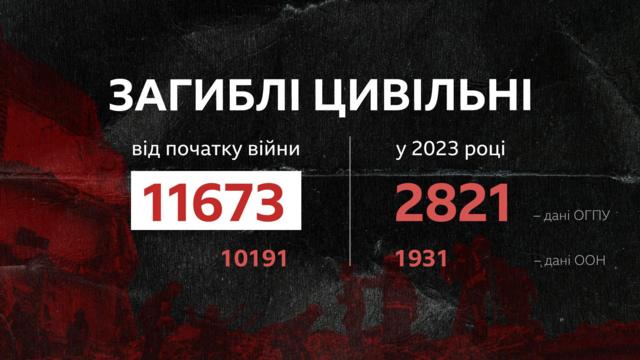
In addition, according to the OGPU, 18,336 Ukrainians were injured from the beginning of the Russian invasion until the beginning of 2024, of which 6,403 were in 2023. At the same time, according to the UN Office of the High Commissioner for Human Rights (OHCHR), the number of deaths in Ukraine since 2014 is lower, namely 10,191 civilian deaths, of which 8,260 in 2022 and 1,931 in 2023.
However, it is noted that the actual number may be higher due to the non-confirmation of some reports. It is also clear that the death toll in 2023 could rise due to the high death toll in early 2024, when 90 people died, according to preliminary UN figures.
It is not possible to establish a precise death toll in the first year of the war in some cities, where heavy civilian casualties were reported due to lack of access due to Russian occupation.
During the second year of the war, officials did not provide specific figures regarding the losses of the Armed Forces of Ukraine. However, the president and his representatives noted daily losses of 30 to 50 soldiers.
In January 2024, the head of the Servant of the People parliamentary faction, David Arakhamia, announced the need to declassify data on Ukraine's losses in the war, but the president has not yet made a final decision.
According to David Arahamia, the number of dead Ukrainian soldiers is much less than 100,000. President Zelenskyi also pointed to the heavy losses of the Russian military.
Human Rights Watch has estimated the civilian death toll in the fighting in Mariupol to be at least 8,000, indicating a potentially significant civilian death toll over time.
According to the "Book of Remembrance of the Fallen for Ukraine" collection, the total number of dead soldiers since the beginning of the Russian invasion exceeds 30 thousand, which became the basis for the creation of the Wall of Remembrance of the Fallen in 2014-2021 in the St. Michael's Cathedral in Kyiv.
There have been attempts to estimate the death toll based on posthumous presidential decrees published by mid-October 2023. Journalists estimated that 14,402 of these soldiers are mentioned. However, there are also closed decrees on awarding posthumously, in particular, employees of the Security Service of Ukraine, the Main Directorate of Intelligence and other special units.
After his appointment as Commander-in-Chief in early February 2024, Oleksandr Syrskyi stated in an interview with the German ZDF that Russian losses, especially casualties, exceed Ukrainian losses by 7-8 times according to the latest data.
Security and defense costs are financed exclusively from tax revenues and other payments that come to the budget from the Ukrainian economy. In 2023, expenditures for these purposes amounted to UAH 2.6 trillion, or more than 40% of the country's expected GDP. This is 72% more than in 2022. Economists estimate that spending on the army alone in Ukraine exceeds a third of GDP. By comparison, in NATO countries with stronger economies, this figure is usually up to 2% in peacetime. 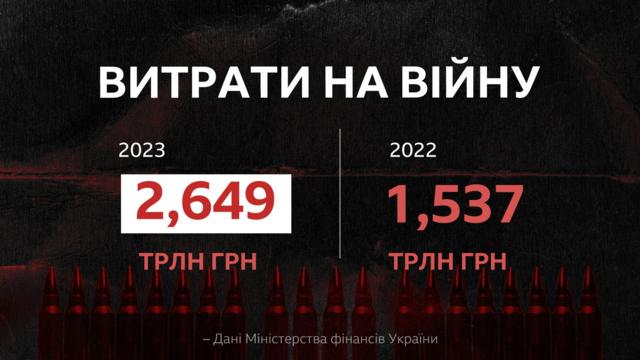
International financial aid covered the other half of budget expenditures, in particular, salaries of civil servants and social benefits. During 2023, aid came in rhythmically and in significant volumes. According to the Ministry of Finance, Ukraine received 42.5 billion dollars in external financing, more than a quarter of this amount were grants, that is, it will not be necessary to return this money. 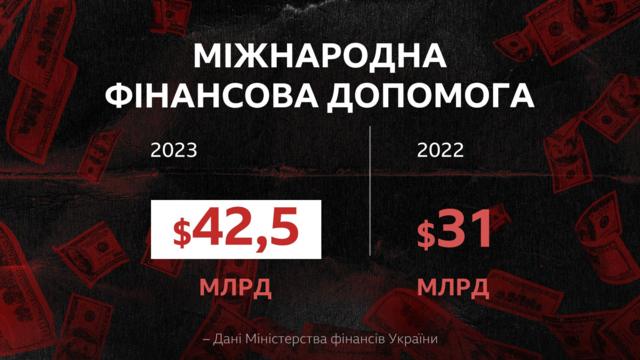
In 2023, the main "sponsor" of Ukraine became the European Union, sending more than 19.5 billion dollars in aid. Compared to the previous year, the United States, which was the leader in terms of aid in 2022, transferred almost half as much - $10.95 billion.
Other major donors of financial aid to Ukraine included the IMF ($4.475 billion), Japan ($3.626 billion), Canada ($1.757 billion), Great Britain ($998 million), and the World Bank ($660 million).
According to the Ukraine Support Tracker, if you "weigh" the aid by the size of the economies of Ukraine's allies, the largest support was provided by the Scandinavian and Baltic countries, in particular, Estonia, Denmark, Norway, Lithuania and Latvia.
In 2023, external financing received by Ukraine exceeded both the volume of 2022 and the expectations of the Ukrainian government. However, it is clear that 2023 will remain a record year. In the 2024 budget, it was initially planned to receive $41 billion from international partners, but the Ministry of Finance later reduced this amount to $37.3 billion.
The destruction and damage caused by the Russian invasion continues to mount. According to the calculations of the Kyiv School of Economics (KSE), the total amount of direct damage caused to the infrastructure of Ukraine increased to 155 billion dollars as of January 2024. At the beginning of 2023, these losses were estimated at 138 billion dollars. The largest share of total losses remains the losses of the housing fund - 58.9 billion dollars. Donetsk, Kyiv, Luhansk, Kharkiv, Mykolaiv, Chernihiv, Kherson and Zaporizhia regions are among the regions most affected by the destruction of housing. 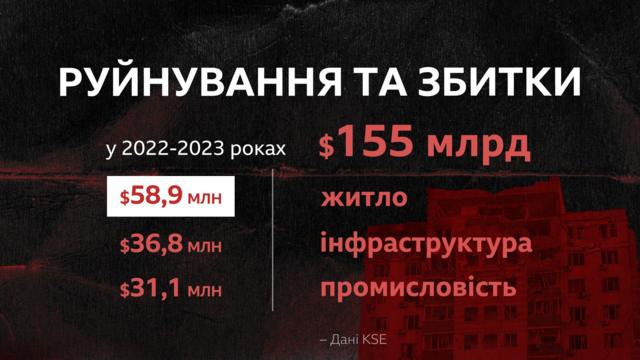
The second and third places in terms of the amount of losses are infrastructure and industry, as well as the losses of enterprises - 36.8 billion and 13.1 billion dollars, respectively. The KSE also calculated that as a result of the explosion of the Kakhovskaya HPP on June 6, 2023, at least 19,000 houses were damaged - they were completely or partially flooded - in only four settlements of the left-bank Kherson region.
According to the latest report of the Office of the United Nations High Commissioner for Refugees (UNHCR), as of mid-February 2024, there were 6.479 million refugees outside Ukraine, of which more than 6 million were in Europe. Of this number, 5.809 million Ukrainians received temporary protection in European countries.
Compared to the first year of the war, the total number of Ukrainian refugees in Europe decreased slightly, but the number of people who received temporary protection increased. According to the UNHCR survey, 80% of refugees from Ukraine are women, while in 69% of cases they were left without family members in Ukraine. The average age of Ukrainian refugees is 44 years.
The largest number of Ukrainian refugees, as of the beginning of February 2024, were registered in Germany - 1.140 million people, of whom more than a million received temporary protection. Poland, which was the leader in the number of refugees from Ukraine in 2022, now has 956,000 Ukrainians. In general, during the war, more than 1.6 million Ukrainians received temporary protection in Poland. According to the UN, there are about 1.252 million Ukrainian refugees in Russia and Belarus. 
There are more than five million internally displaced persons (IDPs) within Ukraine, of which 3.6 million left their homes after the start of the full-scale Russian invasion. According to Iryna Vereshchuk, Deputy Prime Minister and Minister of Reintegration of Temporarily Occupied Territories, more than half of IDPs receive monthly payments. In 2023, more than 73 billion hryvnias from the budget were spent on these payments, which is twice as much as covering all communal subsidies in the country. According to the Ministry of Social Policy, 158,000 people lost their right to payments because they went abroad.
According to data from the International Organization for Migration (IOM), the number of internally displaced people in Ukraine at the end of 2023 was 3.689 million people. Of this total number, almost half came from two regions - Kharkiv and Donetsk. 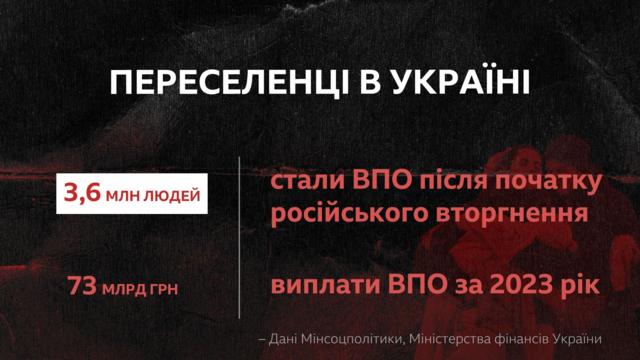
Approximately half of the displaced people also found refuge in the two regions that are actually on the front line - Kharkiv and Dnipropetrovsk (each with a little less than half a million people). In addition, a significant flow of migrants is directed to Kyiv and Kyiv region.
According to the IOM, the main reason why these regions are "popular" is the opportunity to find work. In the western regions, where more than a third of internally displaced persons were in the spring of 2022, only 16% remained by the spring of 2023.
Every second displaced person had the experience of moving more than once, which, according to the IOM, is connected with difficulties in finding a job in a new place. Men were more likely to experience unemployment after moving than women, and one in ten had moved more than three times.
According to IOM estimates, about 4.5 million people have returned to their usual places of residence after a period of displacement - both in Ukraine and abroad. At the same time, 319,000 people who returned from abroad became immigrants in Ukraine.
Most people returned from Hungary, Poland and Romania. It is noted that only 37% of those who returned from abroad receive a regular salary, while the rest depend on pensions and social benefits for IDPs.
Compared to refugees abroad, the share of women among IDPs is lower - about 60%, and the share of elderly people is higher - almost a quarter. In addition, there is a higher proportion of displaced persons who report that they exhausted all their savings during the war.
Regarding economic growth, after almost the third recession in 2022, Ukrainian GDP showed positive dynamics from the second quarter of 2023. Various estimates indicate a possible growth of 5-5.5% in the second year of the war. Final data on GDP dynamics in 2023 will be known later. 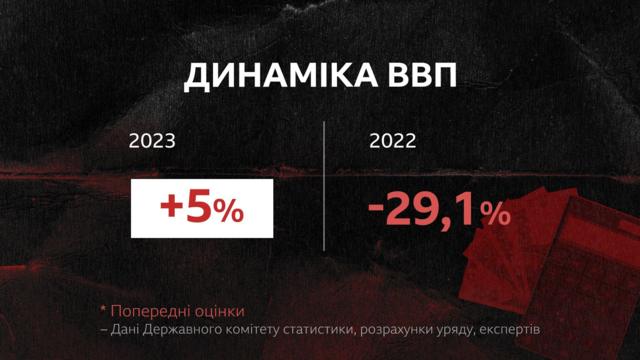
First, it should be noted that the main merit in the form of economic growth is attributed to the low base of comparison. The decline in the first year of the conflict was so deep that even a slight halt in that decline looks like growth. However, despite the signs of recovery, Ukrainian GDP remains about a quarter smaller than in the previous, pre-war year 2021.
On the other hand, the Ukrainian economy has apparently recovered after the initial shocks associated with the beginning of the Russian invasion. Some economic indicators turned out to be better than predicted. However, the effect of the low base of comparison has already exhausted itself, and further recovery will be slower. This is confirmed by preliminary data for January 2024, when, according to the calculations of the Ministry of Economy, Ukraine's GDP increased by only 3.5% compared to January 2023.
Among the indicators that turned out to be better than expected is the hryvnia exchange rate. The national currency of the country, which is experiencing a full-scale war for the second year in a row, has even strengthened for most of the time. Against the background of the fact that the government predicted an average annual exchange rate of 42.2 hryvnias per dollar in the 2023 budget, the real average annual exchange rate turned out to be lower than both government and non-government forecasts.
For a significant period of time, the National Bank decided to abandon the rigid fixation of the official exchange rate of the hryvnia to the dollar, which was introduced from the first days of the war, and switched to "managed flexibility", supporting the hryvnia with the help of currency interventions from reserves. However, at the end of 2023, the hryvnia began to weaken and entered 2024 with an official exchange rate of 38 hryvnias per dollar.
Also, in the second year of the war, positive news regarding inflation, another indicator monitored by the National Bank, was noticeable. If in 2022 Ukraine finished with a price increase of more than 26%, then in 2023 the inflation rate, which cannot be reached even in peacetime, was about 5%. 
The National Bank connects these two indicators as follows: the removal of inflationary pressure allowed currency stability. As for other factors, the harvest year, which contributed to the reduction of food prices, as well as the freezing of utility tariffs, are noted here.
Observers, in turn, point to the refusal to finance the state budget deficit through "printing" of money as one of the main reasons for the stability of the exchange rate and prices. This became possible thanks to the large-scale assistance of international partners, thanks to which the foreign exchange reserves of the NBU reached $40.5 billion in 2023, surpassing the previous record of $38.4 billion in 2011.
Before the start of the war, the Ukrainian economy was largely focused on exports. In 2021, it accounted for about 40% of Ukrainian GDP, which was estimated at more than 68 billion dollars. 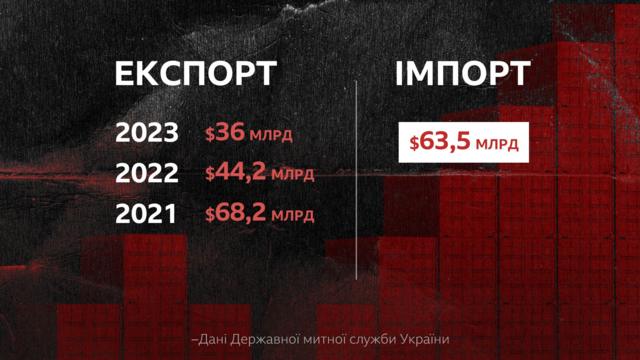
But in the second year of the conflict, export earnings fell to $36 billion. In 2022, Ukraine was able to export 44.2 billion dollars.
At the same time, in the second year of the war, imports to Ukraine actually doubled exports. According to the State Customs Service, in 2023 Ukraine imported goods worth 63.5 billion dollars. And the foreign trade deficit (the difference between imports and exports), even compared to 2022, according to the National Bank's estimates, has more than doubled.
The reason for this was the loss of enterprises in the territories occupied by the Russians, mainly metallurgical ones, as well as systemic problems on all export routes - from the Black Sea to the western borders with European countries, where the "corridors of solidarity" should work. The Russian blockade of Ukrainian ports in the Black Sea and the withdrawal of Russia from the maritime grain corridor forced Ukraine to reorient its exports to the Danube ports. Also, Ukrainian producers began working on their own corridor in the Black Sea, relying on the protection of the Armed Forces.
The end of 2023 showed that seaborne grain exports had practically returned to their previous levels, as at the peak of the possibility of a grain corridor with the participation of Russia and the mediation of the UN and Turkey in 2022. Metallurgical products also began to arrive through these routes. This made it possible to increase the workload of metallurgical enterprises, which began to reach 70% of their pre-war capacity.
However, the western border, primarily with Poland, has, since May 2023, operated with significant restrictions, and even been closed to Ukrainian goods and transport due to protests, first by farmers and then by transporters, who believe that the presence of Ukrainian goods and services destroys their domestic markets.
Despite all this, Poland remains one of the three main partners of Ukraine both in terms of exports and imports.
In general, Ukraine exported the most to the following countries:
- Poland — by 4.7 billion dollars;
- Romania — by 3.7 billion dollars;
- China — by 2.4 billion dollars.
However, the main income - by a large margin from all other items - was brought to Ukraine by the export of agricultural products - almost 22 billion dollars.
The export of metals brought in five times less — almost 4 billion dollars.
Recently, it became noticeable that the export of IT services from Ukraine decreased for the first time in many years - to 6.7 billion dollars. This is more than $600 million less than in 2022.
Compared to the first year of the war, Ukrainians began to trust the authorities much less, and trust in law enforcement and justice bodies fell even more. However, there are institutions and individuals that the majority of Ukrainians trust.
According to a survey by the Kyiv International Institute of Sociology (KIIS) conducted in late November-early December 2023, Ukrainians trusted the Armed Forces of Ukraine the most (96%), and this trust did not change during another year of war.
Volunteers (84%) also enjoy constant and high trust of Ukrainians.
According to a January poll by the Razumkov Center, 95% of Ukrainians trust the Armed Forces, and 78% trust the volunteers. The leaders of the trust also include volunteer units, the State Emergency Service, the National Guard, border guards, and the Security Service of Ukraine.
The majority of Ukrainians still trust President Volodymyr Zelenskyi, but they have become noticeably fewer. According to the Razumkov Center, 64% trust the president's institute itself, while 69% trust Volodymyr Zelensky personally.
However, according to the KMIS survey, at the beginning of February 2024, 65% of respondents trusted Volodymyr Zelensky. And the resignation of Commander-in-Chief Valery Zaluzhnyi "cost" the president another 5% of his trust rating.
In February 2024, 94% of Ukrainians trusted the retired general. His successor as Commander-in-Chief Oleksandr Syrsky is trusted by 40%.
Before the war, according to KMIS, 37% of Ukrainians trusted President Zelensky, but in the first months of the conflict, this figure jumped to 90%. After that, support began to fall - in December 2022, 84% trusted the head of state, and at the end of 2023 - already 77%.
Other central authorities have significantly less trust, and it is declining. According to KMIS data, during the year the number of those who trust the government and the Verkhovna Rada halved.
According to a poll by the Razumkov Center, the Cabinet of Ministers and the Verkhovna Rada are considered leaders in distrust.
In general, in Ukraine, according to KMIS data, there is a decrease in the number of people who believe that things in the country are developing in the right direction.
Significant changes occurred at the turn of 2023 and 2024, when for the first time since the beginning of the war, the number of those who believe that the country is moving in the wrong direction has increased. If after the first months of the conflict, those who supported the correct course were 68%, then by December 2023 their number decreased to 54%, and two months later - to 44%. The Razumkov Center reflects similar results. According to their survey, if before the war in December 2021, only 20% of the population believed in the correct direction of Ukraine's development, after the start of the conflict, by the fall of 2022, more than half of Ukrainians were convinced of the correctness of the course.
The maximum value of this indicator was noted in February-March 2023 - 61%. After that, belief began to wane, and in January 2024, confidence was down to 41%.
Most often, Ukrainians criticize the following areas:
- the level of prices and tariffs (86% for worsening of the situation);
- the country's economic situation (68%);
- level of stability (64.5%);
- citizens' confidence in the future (63.5%);
- the level of well-being of their family (58%);
- attitude of citizens to the authorities (53%).
However, there are also positive changes. Ukrainians note the improvement of the situation regarding the liquidation of the consequences of massive shelling of the energy infrastructure, as well as the improvement of the work of communal services and trade, as well as the provision of food.
The most obvious positive changes of recent times, according to Ukrainians, relate to Ukraine's defense capability and international image.

